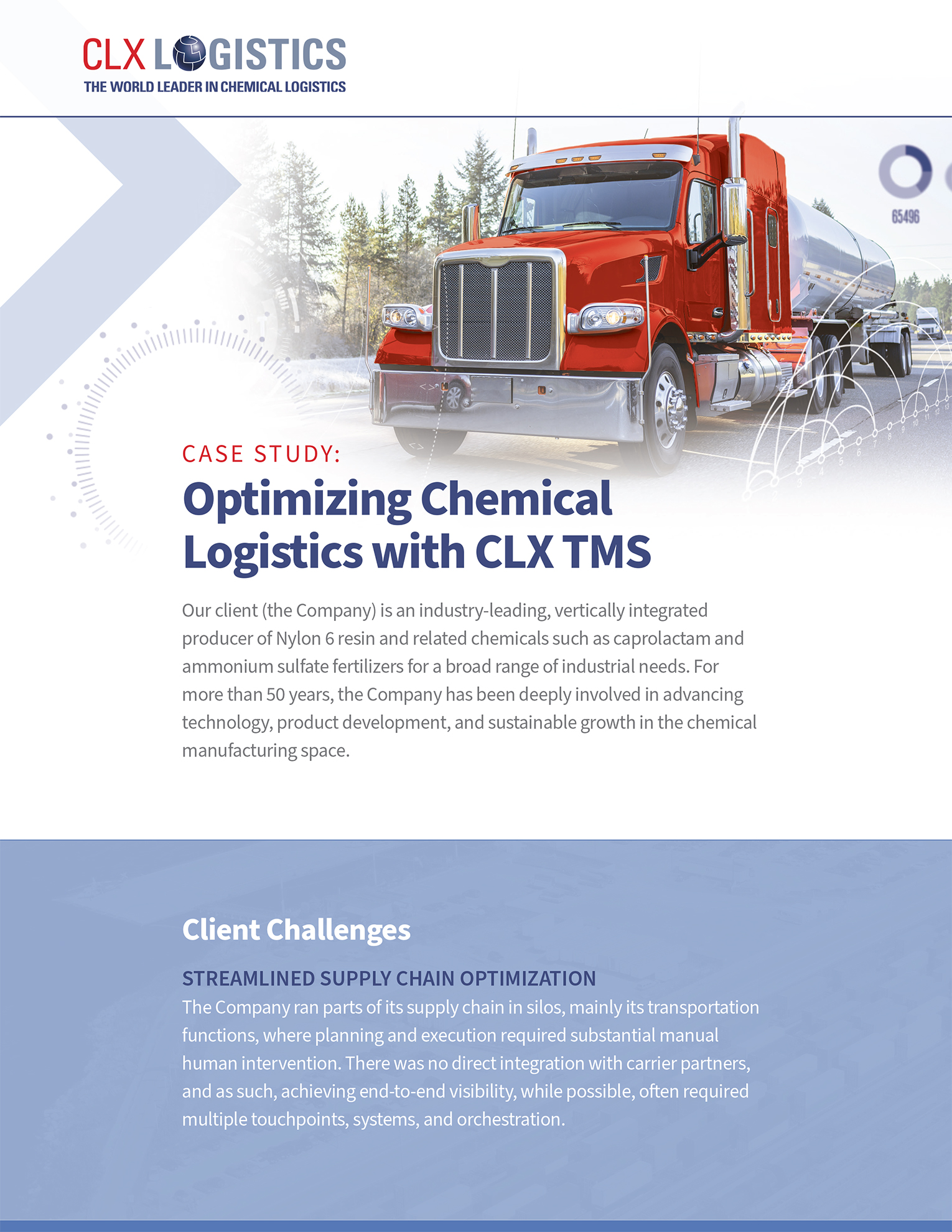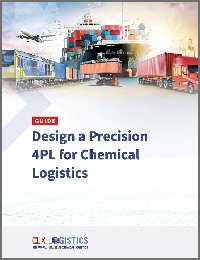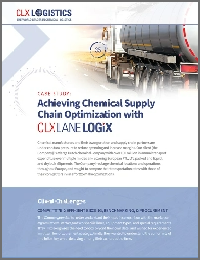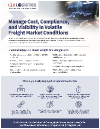 Powered by e2open
Powered by e2openThe Only Globally Deployed Enterprise-Scale SaaS-TMS
Plug into the CLX Global TMS global carrier network and track your journey towards best-in-class. CLX Global TMS powered by e2open is a global logistics platform that enables chemical shippers to plan, execute, and optimize transportation operations and ensure delivery performance to partners and customers anywhere in the world while ensuring compliance and maximizing efficiency.
CLX Global TMS provides advanced visibility and control over your day-to-day transportation operations with interactive dashboards and real-time metrics that allow shippers to identify outliers and trouble spots that need attention. By streamlining the chemical shipping process, we make it easier for businesses to manage and optimize logistics operations over road, ocean, rail, and intermodal networks.
Get Started Today
What is TMS?
A transportation management system (TMS) is a logistics technology platform that helps businesses plan, execute, and optimize the transportation of incoming and outgoing goods and ensure shipments are compliant and properly documented. This kind of system is often part of a larger supply chain management system. A TMS provides visibility into shippers’ transportation operations, trade compliance information, and documentation and ensures the timely delivery of freight and goods. A TMS is essential in modern transportation and logistics to help streamline shipping processes and facilitate better management of transportation operations, no matter the modes used.
What is a TMS system today? Modern TMS software includes features that can dramatically reduce complexity and improve efficiency. Key features include:
Load planning (route optimization, modal conversions, carrier management)
Load execution (booking, tendering)
Freight tracking (status updates)
Payment (settlement, auditing, billing)
Optimizations & Reporting (KPI tracking, analytics)
Benefits of CLX Global TMS powered by e2open
CLX Global TMS is a world-class global transportation management system that offers plug-and-play speed, efficiency, and supply chain visibility to chemical shippers worldwide through a transportation ecosystem. CLX Global TMS enables shippers to substantially automate transportation planning, execution and invoice settlements functions, cost and service level optimization, visibility, metrics, and analytics.
- Chemical Logistics Experts who know how to best resolve specialty equipment and product compatibility challenges as well as how to comply with stringent regional and global regulations.
- Optimize networks for load planning, contracts, and route guides using CLX Gravity.
Take Control of Your Logistics Spending - Solve capacity management issues for all freight flows.
Six Critical Key Performance Indicators - Manage all modes of transportation in a single system.
Get the Best from your TMS - Execute carrier agreements and dashboard logistics carrier compliance and cost metrics.
Optimizing Chemical Transportation Logistics to eliminate risk & reduce spending - Gain supply chain visibility across all regions and facilities.
Advanced Transportation Visibility - Automate freight payment processing, booking, visibility, and alerts.
Does Your TMS Carry its Weight? - CLX LaneLogix’s Gartner-recognized Procurement, Benchmarks & Bids that continuously identify savings and improvements after go-live
Guide: Effective Chemical Freight Procurement, Bidding, and Benchmarking

CLX Logistics
Chemical Experts
e2open
Cohesive Platform
Success for Chemical Shippers
offering unique market
understanding, strong vision
& a competitive price point
Multiple Processes, One System for All Markets
Chemical shippers face more difficulties than ever in delivering products faster and at lower costs as capacity constraints and fluctuating fuel prices create significant challenges. CLX Logistics combines its TMS platform, as recognized in Gartner’s Magic Quadrant for Transportation Management Solutions, with white-glove service to deliver customized solutions for specialty sectors, including chemical freight and food and beverage. CLX Global TMS powered by e2open simplifies and optimizes domestic and international logistics for chemical shippers, freight forwarders, carriers, and logistics service providers by providing capabilities based on your specific needs to serve your customers better.
CLX Global TMS powered by e2open is a single application purpose-built for your business’s unique volumes and workflows, covering all modes and regions with full functionality for planning, carrier procurement, execution, tracking, and settlement.
Gartner recognizes e2open as a Leader in the 2022 Magic Quadrant for the Multi-enterprise Supply Chain Business Network marketplace. Its acquisition of BluJay Solutions in 2021 has also helped the brand provide additional support to clients with expanded functionalities. Read More about the Gartner Recognition
CLX Global TMS powered by e2open enables world-class transportation solutions with plug-and-play speed to value. The CLX Logistics Deployment Methodology ensures on-time projects that deliver ROI at go-live, offering positive cash flow in one to four months and full cost recovery well within the first year. To augment and enhance your transportation management operations, CLX Logistics also provides seasoned expertise with tailored value-added services that ensure you deliver on time in full every time.
- 60+ chemical industry deployments of our transportation management system
- Unparalleled insight and expertise automating and optimizing global freight networks
- 20+ years resolving complex and demanding international chemical freight requirements

Technical Features of a TMS
CLX Global TMS powered by E2open provides a single application purpose-built for your business’s unique volumes and workflows, covering all modes and regions with full functionality for planning, carrier procurement, execution, tracking, and settlement.
VISIBILITY
across the entire global transportation network
QUICKER ROI
typical payback within 6-9 months
REAL-TIME DATA
through one single SaaS solution
CENTRALIZED CONTROL
to manage transportation
SCALABLE INFRASTRUCTURE
and adaptable technology
ABILITY TO MEET
multi-regional regulations and guidelines
EXPERT OPTIMIZATIONS
benchmarking with the world’s largest chemical freight database
Multiple Processes, One System for All Markets
In today’s world, where complex supply chains, shifting transportation choices, fluctuating market variables, and demanding customer requirements are the norm, having just any TMS can be as bad as having no TMS. Effective logistics management continues to be at the forefront of company operations and digital supply chain transformation, critical to the efficient flow of goods in the global economy. To handle the complexity, companies need to take measures to implement a robust TMS equipped for today and tomorrow.
CLX Global TMS’s fully integrated carrier network brings real-time visibility into your entire global and domestic supply chain. Supported by CLX Logistics’ unmatched expertise, adaptability, and flexibility, you get the absolute best planning and execution capabilities across your network.
READ SOME OF OUR LATEST TMS RESOURCES
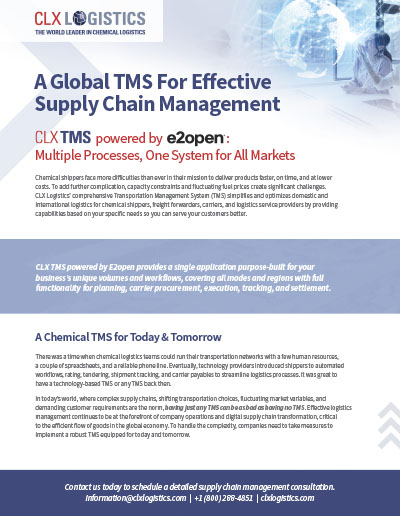





What Our Clients Are Saying
We’ve been live for over a month, and typically I would have closed [the project] earlier, but it was so smooth that I lost track of time! I have to admit, this was by far my favorite project to work on, and it isn’t just because of its speed, a record 4.5 months! Your team is among the best I’ve worked with. They’re engaging, involved, help make decisions to keep us going, understand our needs, and course-correct effectively. Our success reflects the strength of CLX and our partnership. We’re grateful for CLX Global TMS and the optimizations it brings to our approach, so thank you.
Save Time, Save Money & Improve Service with TMS
Increased Profitability for Everyone
Many large companies struggle with distribution challenges and high transportation costs. Transporting chemicals from one point to another requires a safe and carefully coordinated approach, especially since transportation spending is more variable in today’s environment. Consequently, a 1% improvement in supply chain efficiencies can significantly improve profit margins. However, managing every shipment stage—over the ocean and the last mile—can be highly complicated, especially during ongoing supply chain disruptions. CLX Global TMS provides the broadest visibility and carrier coverage across all modes and re-usable connections to shippers, forwarders, 3PLs, and others to help orchestrate simple and complex supply chain scenarios.
Higher Levels of Service
Chemical suppliers are under constant pressure to deliver their goods safely, more quickly and efficiently, on time, and at lower price points. At the same time, limited capacity and unpredictable fuel costs create strong headwinds. Without visibility into open capacity, comparative rates, and performance history, organizations often incur higher costs per mile, face numerous delivery delays, and settle for less-than-perfect service. CLX Global TMS answers these concerns with access to the largest carrier network across all modes and regions, plus strong partnerships with digital freight brokerages and a single unified platform so you can select the optimal provider for your shipments.
Enhanced Shipment Tracking and Tracing
Visibility into the status of your shipments provides all stakeholders with reliable, real-time updates for goods on the move. Carrier updates through CLX Global TMS’ global network powered by E2open’s e2net provide accurate answers to the question “Where’s my stuff?” This capability helps business leaders make optimal decisions in any scenario.
Connected Global Trade, Channel, and Supply Chain Ecosystems
Transportation Management is part of CLX Global TMS’ connected supply chain platform. CLX Global TMS provides a unique, end-to-end, cloud-based platform architecture, best-of-breed applications, and harmonized, decision-grade data from an expansive multi-tier global network of suppliers, manufacturers, transporters, and fulfillment channels. All this combines as a single source for real-time insight and actionable information across your entire chemical supply chain. The end value is a connected and efficient supply chain moving as one.
Scaling with your Business
Shippers have access to a variety of TMS options. The key to choosing the right TMS is to select one that aligns with your network’s level of complexity. To put it as simply as possible, if your TMS hasn’t brought you significant savings, you need a new one. CLX Global TMS enables world-class transportation solutions with plug-and-play speed and efficiency that scales as your business size and needs change. The CLX Logistics Deployment Methodology ensures on-time projects that deliver ROI at go-live, offering positive cash flow in one to four months and full cost recovery well within the first year.
To augment and enhance our Transportation Management Services, CLX Logistics provides real-world expertise with customized supply chain services that ensure you deliver on time in full every time. CLX Global TMS’s fully integrated carrier network brings real-time visibility into your entire global and domestic supply chain. Supported by CLX Logistics’ unmatched expertise, adaptability, and flexibility, you get the absolute best planning and execution capabilities across your network.
READ SOME OF OUR LATEST TMS RESOURCES
